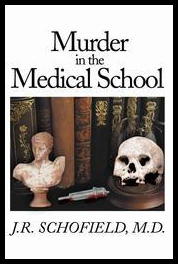Thu 21 Jun 2007
Death Noted: J. R. SCHOFIELD, M.D. (1923-2007).
Posted by Steve under Authors , Crime Fiction IV , Obituaries / Deaths Noted[9] Comments
Al Hubin and I are convinced that we have correctly identified the author of Murder in the Medical School (iUniverse/Writer’s Club Press, December 2000), as Dr. James Roy Schofield, who died on May 20th, 2007.
The reason I’ve phrased that opening paragraph the way I have is on the page where the book is for sale on Amazom.com, the author is said to be Jill R. Schofield, M. D. The latter name is also somehow connected with the ISBN number, since at least half of the sellers on ABE have entered it that way, also referring to the author as Jill. A check on Google uncovers a Dr. Jill Schofield with a practice in Aurora CO.
On the other hand, and even more convincing, is Dr. James Roy Schofield’s Who’s Who entry, and his book, a mystery novel which just managed to make the end of 2000 deadline for inclusion in Crime Fiction IV, is definitely mentioned, along with some other data about him.
Born July 12, 1923, Dr. Schofield received his MD from Baylor University in 1947 and a LLD from Queens University in Ontario, Canada, in 1988. As an educator, he was a member of the faculty of the Baylor University College of Medicine from 1947 to 1971, eventually becoming its Academic Dean. After leaving Baylor, he worked for many national medical associations, including the AMA, as a consultant on medical education.

All of which certainly means that the background for his mystery novel was authentic. Here’s a description of the book, as taken from the back cover:
The novel begins with preparations by the Anatomists to prepare a teaching exhibit of human structures in one-inch cross-sections of a human cadaver.
The medical school is expanding into new clinical departments; recruitment of several departmental Chairs is described – showing the quite variable characteristics of several clinical specialists.
The narrator describes life in and problems of the medical school. The reader can follow selection of new medical students, academic disputations about the M.D. curriculum behavior of some physicians in private practice, split opinions over the locations of the new charity hospital and a typical M.D. graduation ceremony – with the administration of the ancient Oath of Hippocrates to the graduates. The narration is flavored with references drawn from the History of Medicine.
Was there a murder? A person on staff of the medical is missing; but no body could be found. The arrival of the missing person’s girl friend triggers the attention of the police; but, until the penultimate chapter, there is no solution until the two young anatomists convince the detective that they have solved the missing body question.
Not until the Epilogue, is the identity of the murderer revealed, and how he did it.
Perhaps it was never a bestseller, but more than six years later, Amazon still has copies of Murder in the Medical School in stock. Its sales ranking is #2,521,639, but the number must be put in perspective. Amazon offers well over four million books for sale.
July 25th, 2008 at 9:14 pm
I can verify that I knew this remarkable man personally, and yes — he is, in fact, the author of this book. He will surely be missed by many…
July 25th, 2008 at 10:11 pm
Andrew
Thank you for confirming that we’ve correctly identified the man who wrote Murder in the Medical School.
Based on your brief statement, it’s also obvious that behind his resume — as impressive as it is — was a man just as impressive, if not more so.
Best
— Steve
September 17th, 2008 at 1:33 pm
Thank you Dr Schofield for the advice, the education, and the chance to know you. you will be sorely missed.
August 27th, 2009 at 9:18 am
Jim Schofield was a dedicated physician educator who commanded respect. His no-nonsense administrative style provided strong leadership and inspired excellence. He also was a deeply spiritual man with a wry wit. He did not wear his faith on his sleeve. I am proud to have known him.
—Peter
October 23rd, 2009 at 4:50 pm
Hey, I am the owner of a second hand / curio shop in Southern AZ. I found a pocket sized New Testament Bible with the imprinted name of “Dr. James R. Schofield” and a hand written dedication in it, “To James Schofield Graduation May 1947, From Willard & Telma Weeks, Ps 119:11” In it. I am trying to locate living family that might want this item returned. Please contact me on facebook at Don Driver if you have information that would help. Thanks. Don….
October 24th, 2009 at 10:37 am
Dr. Major Bradshaw a dean at Baylor Med might be able to locate Dr. Schofield’s family. Or the alumni affairs office at Baylor–Write him– care of Baylor College of Medicine 1 Baylor Plaza Houston texas 77030
October 24th, 2009 at 1:57 pm
Thanks, Peter. I’ve passed the info on to Don.
October 18th, 2011 at 2:54 pm
I also was looking for a Dr. R Schofield who worked in the psychology dept in both Alberta and British Columbia. Could this likely be the same gentleman? Any help would be appreciated. Thank you.
September 29th, 2013 at 11:50 am
The author was in fact James R Schofield, MD. He was my uncle. He did not work in a psychology dept in Canada. If the bible is still present, we would like to obtain it. Yes, he was an impressive man.